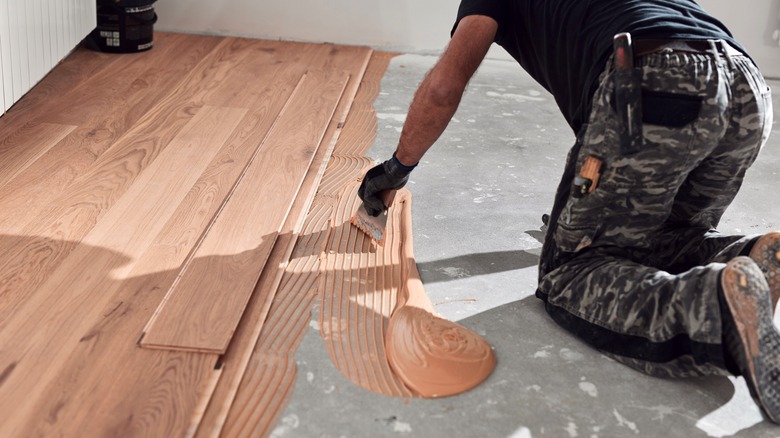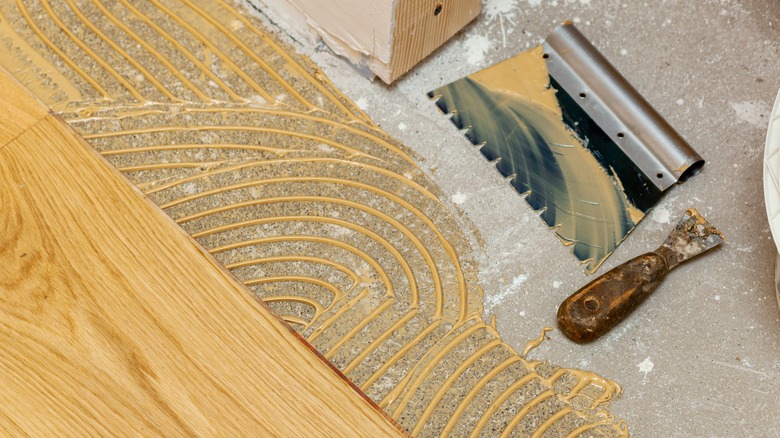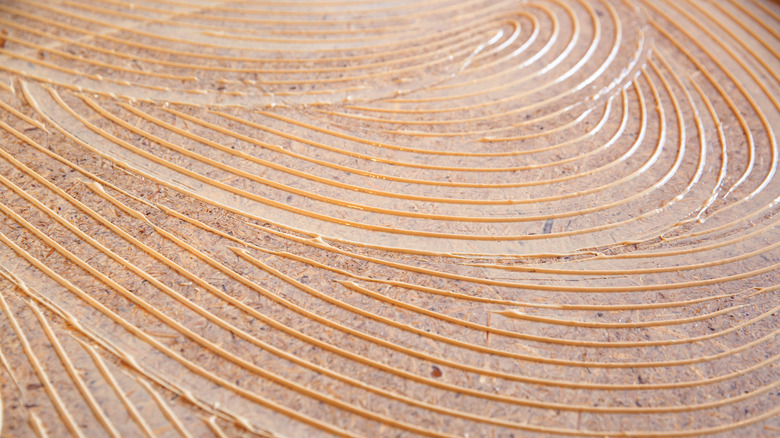Prevent Wasting Glue When Laying Flooring With These Must-Know Tips
When it comes to installing hardwood floors, there are a variety of installation methods available. Although floating, nailing, and even peel-and-stick options abound, the glue-down method works for a wide range of flooring types and provides a number of important benefits. When you use glue, you'll not only create a more secure bond that lasts, but you'll also reduce the amount of squeakiness that can happen over time, and give your floors an added moisture barrier that works especially well in high humidity. According to Skylar Bartlett, Owner at Kreer Construction, wood glue can be expensive, which is why she recommends using the right tools, working in small sections, and keeping your glue covered to prevent drying out if you don't want to waste any while you're working.
"Glue isn't cheap, and if you're working on a larger install, small waste adds up quickly," Bartlett told House Digest during an exclusive interview. It may be counterintuitive, but the construction expert added that using more glue doesn't necessarily mean your floor will be stronger. "Overapplying can lead to longer cure times, messy oozing at the seams, and even affect how the floor sits," she explained. Using too much glue is one way you can quickly waste it while laying new floors. But according to Bartlett, "wasting glue usually comes down to bad prep or the wrong tools."
It's crucial to use the right tools and techniques
During her exclusive interview with House Digest, Skylar Bartlett shared a number of tips that will help you avoid wasting floor glue when laying hardwood floors. It's one of the easiest ways you can save money on your next flooring installation. "Use the right trowel for the job," Bartlett said. "Every glue has a recommended trowel notch size which is usually listed right on the bucket." She added that using the wrong trowel size means you'll end up applying way more glue than necessary. After you've purchased the right tool, the construction expert recommended working in sections instead of applying glue across the entire floor all at once: "Only trowel out what you can realistically lay flooring into within 30–45 minutes." Otherwise, you can expect to spend extra time scraping dried glue that will have to go straight into the trash, and reapplying even more glue (which can really eat into your budget.)
While you're working, Bartlett suggested keeping your bucket of glue well covered. "Letting too much air in causes the surface layer to start drying out, and once that happens the whole top gets gummy and wasteful," she explained. You'll also want to keep your trowel clean as you work. The expert said she likes to cut a small notch into her bucket to get rid of any excess glue during the application process. "Dried glue on your trowel teeth throws off the application pattern and leads to excess build up," she said, adding that you should wipe it off regularly to keep your glue application even.
Minimizing waste comes down to good technique and avoiding common mistakes
Once you've determined that glue-down wood planks are the best flooring option for your home, a successful installation that avoids wasting glue comes down to good technique. "Use a trowel with the correct notch size and hold it about a 45-degree angle," Skylar Bartlett said during her exclusive interview with House Digest. The construction expert emphasized that you should aim for smooth and consistent strokes, only covering enough area to lay a few boards at a time. "I like to picture drawing rainbows because your motion should be even and slightly arched, not choppy," she said. To accomplish this, she recommended applying steady pressure that keeps the notches of your trowel in contact with the subfloor to create ridges in the glue. "Press too lightly, and you'll miss spots. Press too hard, and you'll flatten the ridges, which affects how well the floor bonds," she cautioned. According to Bartlett, your goal is to achieve even ridges that provide solid contact and eliminate puddling or air pockets.
Lastly, the construction expert said to prevent waste you should avoid some common mistakes. Along with using the wrong trowel or applying too much glue too soon, she said to avoid letting your glue skin over. "Once the glue surface starts to dry, it won't bond properly and often has to be scraped and redone," Bartlett explained. She also said you should avoid sloppy habits that get glue on your tools, subfloors, or your new flooring itself. Keep rags and cleaner close so you can frequently wipe them off: "Prevention is way easier than trying to fix dried adhesive later."


